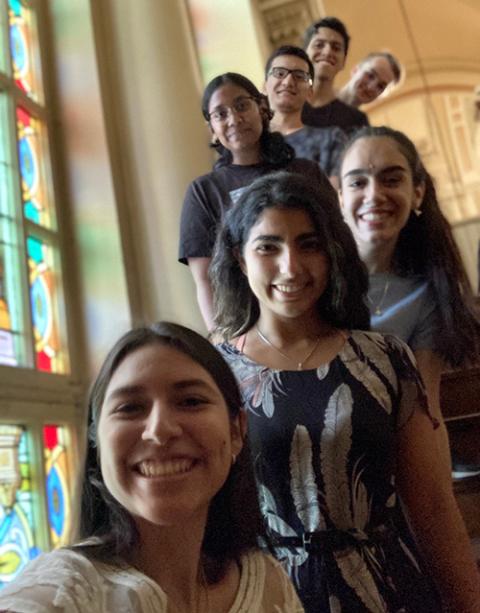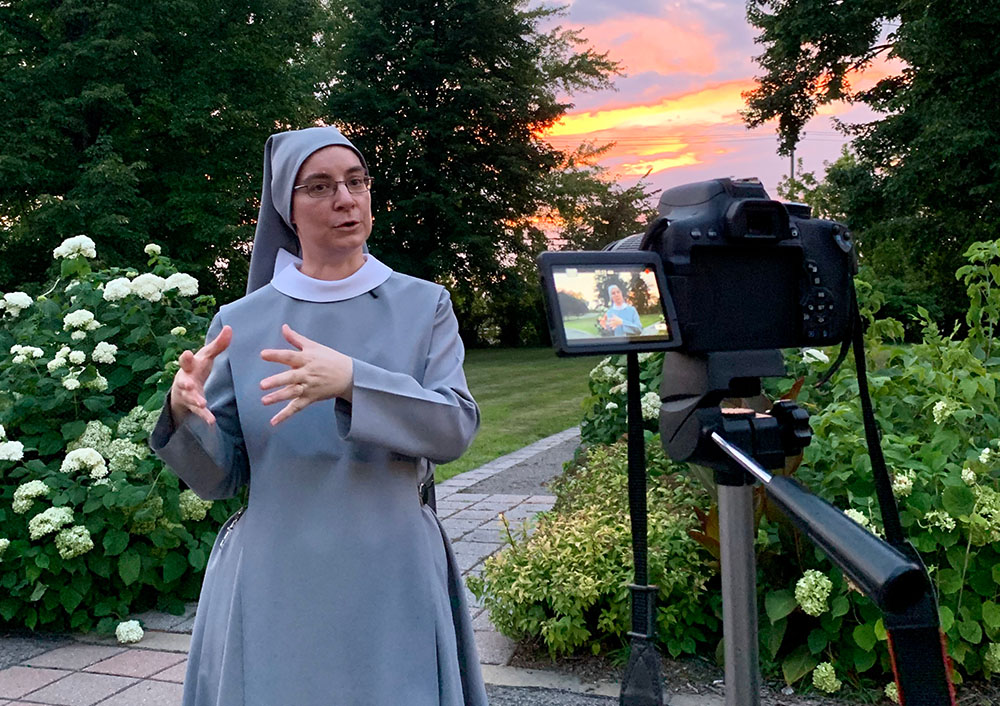
Recluse Sr. Ginette Généreux speaks during the filming of the documentary series "The Hidden Good in the City" ("Le Bien Caché dans la Cité") by the youth of Mission Jeunesse in the Montreal Archdiocese. (Courtesy of Mission Jeunesse)
"The Hidden Good in the City" ("Le Bien Caché dans la Cité") is a collection of short documentaries launched in November 2023 on YouTube by two offices of the Montreal Archdiocese: a youth ministry called Mission Jeunesse and the Office for Consecrated Life. The series celebrates inspiring stories of religious life that often go unnoticed in the busy heart of Montreal.
Seven members of Mission Jeunesse, directed by Isabel Correa and mandated by the archbishop of Montreal, reported on five religious to help demystify the vocation of religious members. This team's mission is to propose Jesus Christ to teens and young adults, calling them forth as missionary disciples of the new millennium.
The goal with the YouTube series is to introduce particularly young audiences to "hidden gems" within the city.
The series was made possible with the financial support of the Lucien-Labelle Foundation. The entire project took a year and a half and was the initiative of the Office for Consecrated Life.
"The project emerged from a formidable challenge: countering the negative portrayal of individuals in consecrated life perpetuated by the media," the office says on the archdiocese's website. "The aim was to shed light on those who have devoted their lives to serving their neighbors, especially the most vulnerable. Despite their ongoing and historical acts of kindness, these individuals often remain unknown."
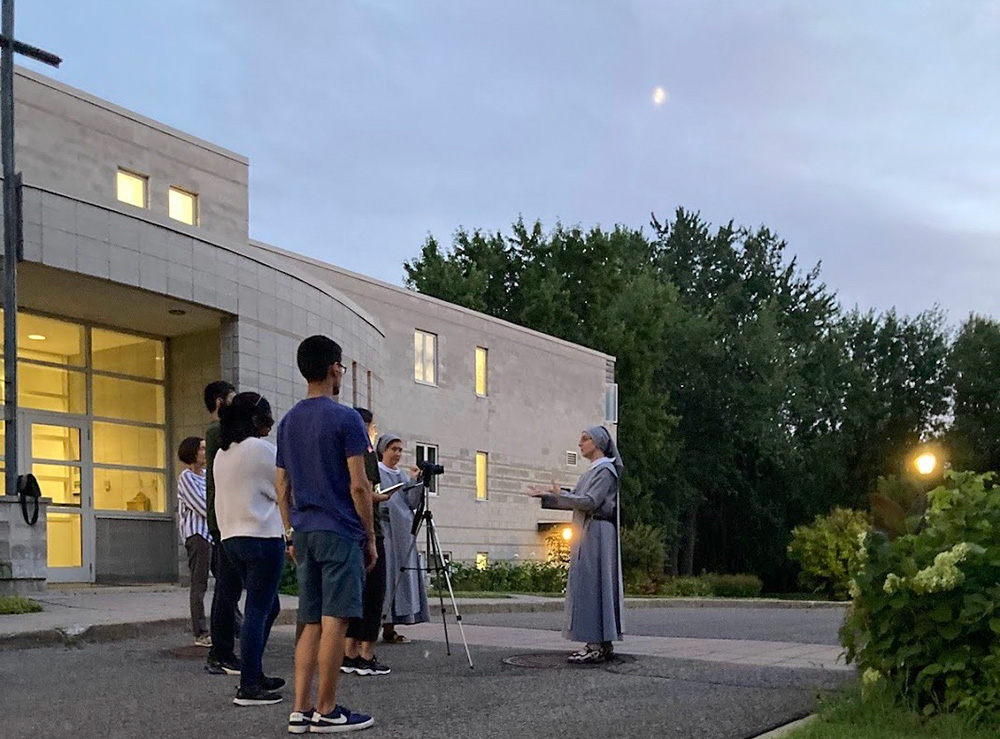
Nighttime filming of the documentary series "The Hidden Good in the City" in front of the Recluse Sisters' monastery in Montreal (Courtesy of Mission Jeunesse)
The videos can be presented in parishes and groups, which can help to open up a dialogue with the younger generation on the existence and meaning of religious life. The videos can also be used to promote vocational pastoral care.
Sr. Ginette Généreux is featured in the series. She is part of the Recluse Sisters, a contemplative community that unites monastic tradition and recluse tradition, following the example of Montreal recluse Jeanne Le Ber (1662-1714). The sisters take turns to perpetually adore Christ present in the Blessed Sacrament. In French, they call themselves the "Missionary Recluses" as they consider themselves missionaries through their intercessory prayer.
Généreux participated in the "The Hidden Good in the City" series' fourth episode and agreed to tell Global Sisters Report more about her experience.
GSR: In what way are the Recluse Sisters active?
Généreux: Our prayer life is truly our special mission in the church. Worshiping the Lord and interceding for our brothers and sisters in humanity makes us present to God today in the lives of the people we meet or who confide in us.
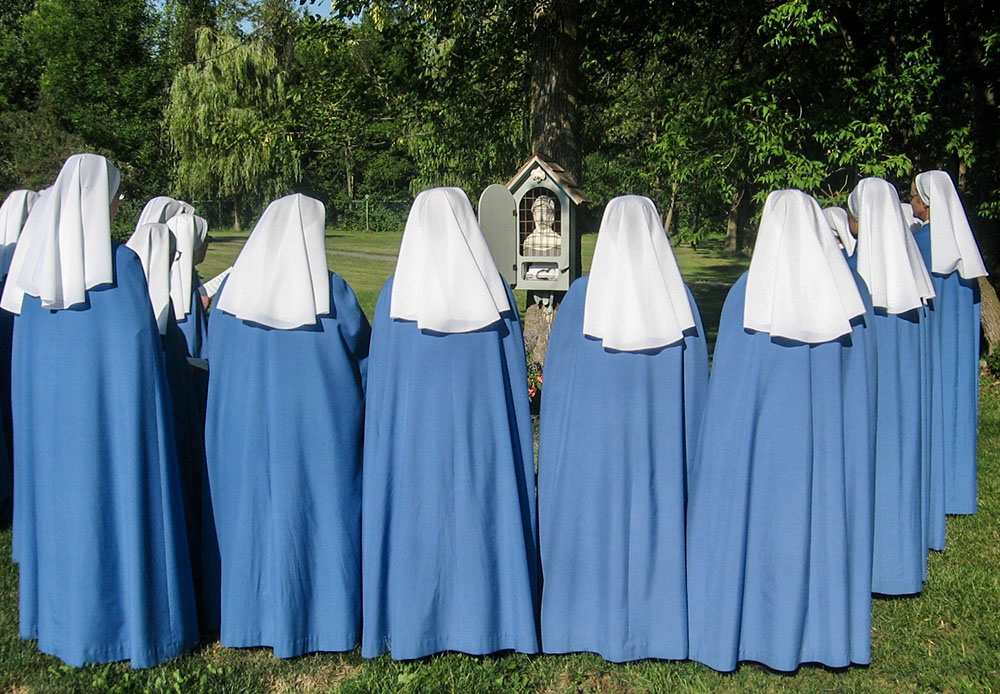
The Recluse Sisters gather for a moment of prayer. (Courtesy of the Recluse Sisters)
Our mission of prayer doesn't leave us with our arms folded but makes us truly attentive to people's human and spiritual needs. And our monastic guesthouse, where we welcome guests in a climate of silence and recollection, is a concrete way of embodying our life of prayer.
The two dimensions of adoration and intercession are communicating vessels towards communion: communion with God and communion with others. This "activity" is full-time!
What do you think of the series "The Hidden Good in the City"?
It's a wonderful initiative that has led to some inspiring encounters. The series presents itself nicely and gives us a glimpse of the richness of the different callings of the people interviewed.
As a participant in this project, what message did you share on YouTube?
During the interview, I let myself be guided by the young people's questions. What they retained from our interview and transmitted on the video is our mission of welcoming others through our monastic hospitality.
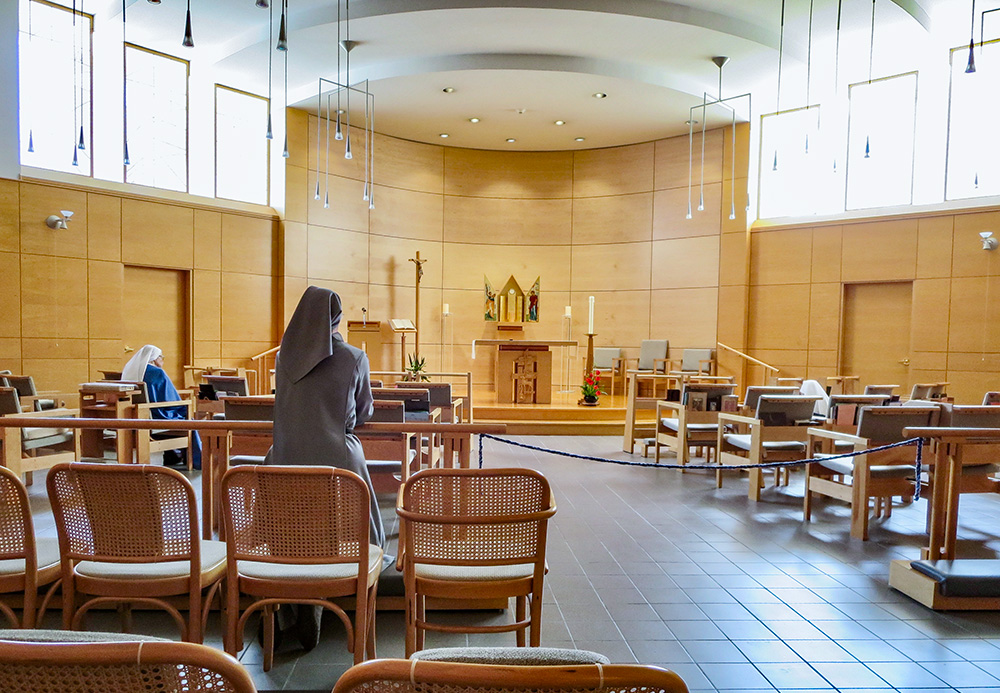
Sr. Ginette Généreux prays in the Montreal Recluse Sisters' chapel, as she does daily. (Joanna Kozakiewicz)
A contemplative vocation makes us sensitive to welcoming everyone as they are, whatever their life path is. It's important to offer places of welcome where anyone can come and recharge their batteries in silence and prayer. And our prayer of adoration and intercession opens us to this dimension of unconditional welcome.
Why do you think young people today need to hear the message you've shared with them?
It's probably important to hear that faith in God, when it's true, doesn't enclose, but rather creates a space where all can find their place. In a world that seems increasingly polarized, it's good to witness a way of life based on welcoming others and hospitality that implies openness to others. This reflects God's unconditional welcome to each and every one of us.
How do you hope your participation in the videos can impact young adults and even adults?
I can't really know what impact my participation has had and will have, but I do believe that being firmly rooted in my being and my calling can only have a positive impact.
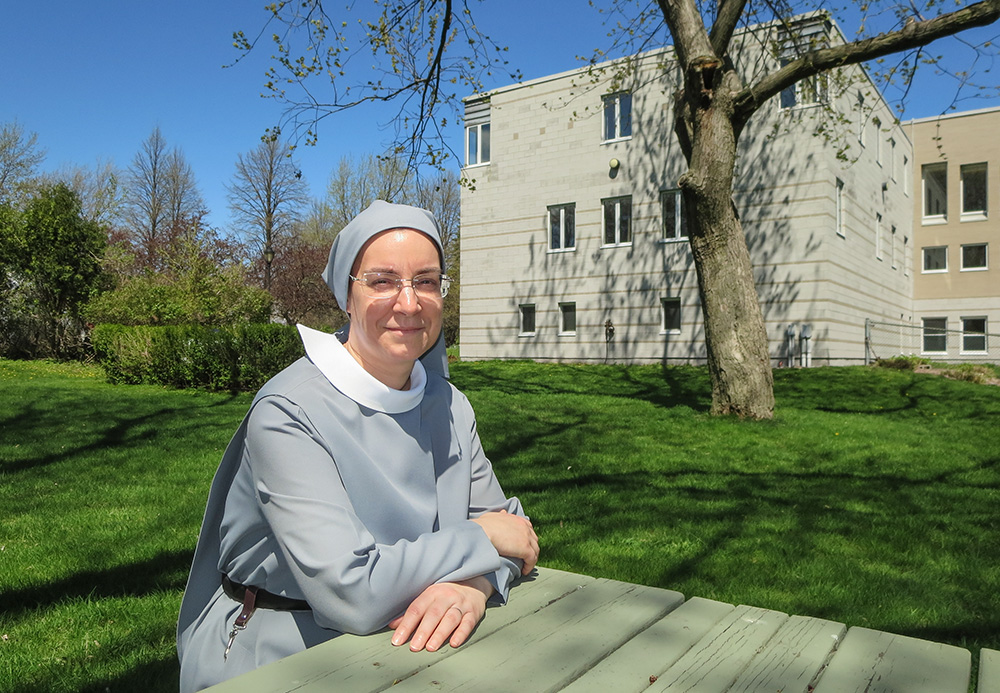
Sr. Ginette Généreux sits in the backyard of the Recluse Sisters' Montreal monastery. (Joanna Kozakiewicz)
It's the Holy Spirit at the core that touches hearts! However, I do hope that my testimony awakens in the hearts of young adults the desire to seek out the call placed in them by the Lord and to correspond to it, to be truly happy as they blossom in the gift of themselves for the good of all.
What motivated your participation in the documentary series? It's a dynamic project that undoubtedly required you to step outside your contemplative routine.
Yes, indeed. It required me to go beyond the call of duty and to do it freely. But the project was well-constructed and gave me the opportunity to be with young people already involved in their faith. I was curious to meet them!
Also, as the request came from the Office for Consecrated Life and we are diocesan (i.e., a diocesan institute), it's important for us to show that we are present.
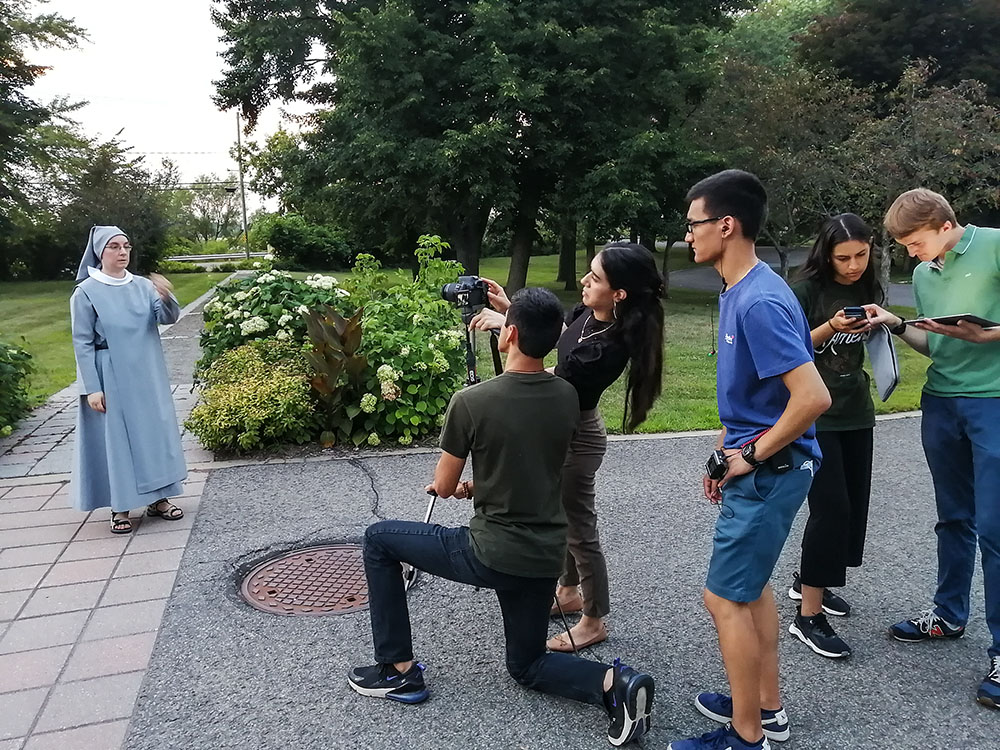
The youth of Mission Jeunesse in Montreal film Recluse Sr. Ginette Généreux and monitor the sound and light for the series "The Hidden Good in the City." (Courtesy of Mission Jeunesse)
What was it like recording and working with the young adults?
The contact was very natural, and I don't think there was any awkwardness on either side. As they knew each other well, there was a real sense of brotherhood.
So the recording went very smoothly. They had their plan, and I let them guide me. The fact that they chose to record outside with the setting sun as a backdrop created a relaxed atmosphere for the interview. On the other hand, it gave them more work to do later in the editing because of the sounds of the locusts. But during the interview, I wasn't distracted by the background noise.
Why do you think it's important to involve young adults in similar projects on YouTube or social networks to raise awareness of the religious vocation?
Because they are the ones who share what has touched and reached them. And they share it in their own way, closer to the sensibilities of today's youth. Basically, it's their discoveries and experiences that they share, and young people like to discover through the eyes of others.
Why do you think nuns should get involved in social networks like YouTube?
To help demystify religious life. As most young people today no longer have much contact with religious men and women, there is now a great deal of unknown.
Making ourselves visible on YouTube and social networks can help people see that we're ordinary, down-to-earth, accessible people. We're not extraterrestrials; on the contrary, we've got both feet on the ground, and perhaps more so than many people.
How can involving nuns on social networks like YouTube help the religious vocation?
I see this involvement as an opening door, a little hello, to where most young people are. For me, social networking is a means to an end, not an end in itself. Because a short, eight-minute video doesn't tell the whole story about religious life.
This medium can be a turning point for young people searching on social networks. But after that, it's time for a real face-to-face encounter so that there can be serious reflection and discernment about a possible call.
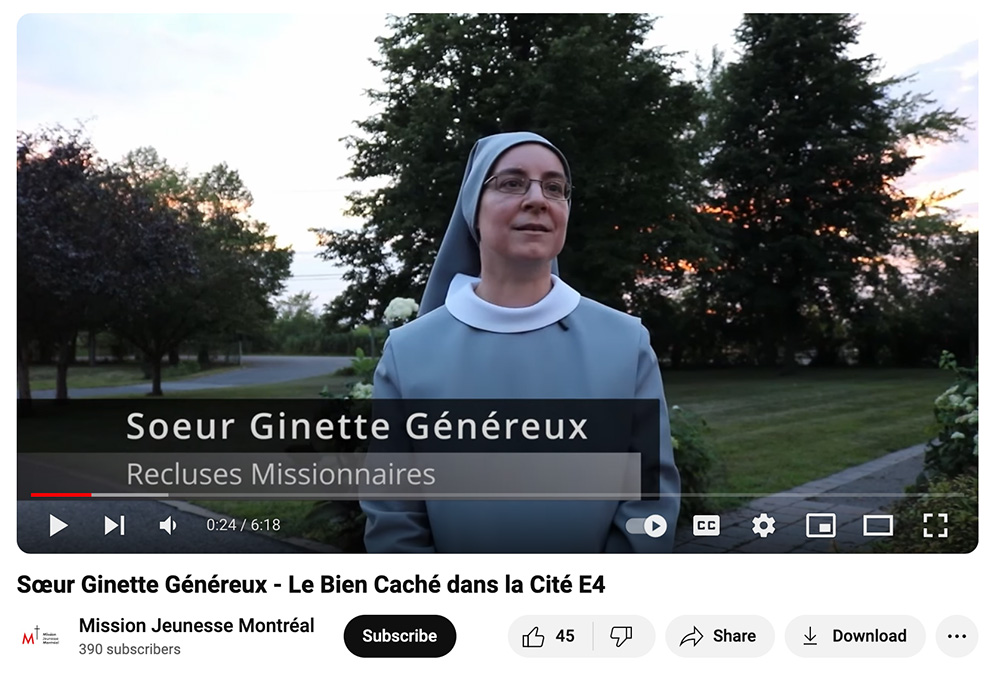
A scene from the documentary series "The Hidden Good in the City" appears on Mission Jeunesse Montréal's YouTube channel. (GSR screenshot)
We can't stay in the virtual world indefinitely, to the detriment of the reality. For it's in the real world that you find your way and realize your full potential as a person.
Do you think that social networks like YouTube play an important role in evangelization and the promotion of religious/consecrated vocation?
Yes, I think they play an important role in that the subjects they tackle and the way they approach them are in line with young people's interests and questions. And for this to happen, you need a lot of tact and, I'd say, personal charisma on the part of the religious.
I've come across a few of them on YouTube, and my hat's off to them. To have a real impact, you need a regular presence on the networks so that the initial click can be transformed into prolonged interest and finally spark a progression in the young person. It's quite an art!
In fact, even the latest popes are urging us to be present in this "digital continent."
Advertisement
Do you think this series could affect pastoral care and help promote religious vocations?
I believe the series is becoming a fine tool for addressing the question of vocation to religious life. It contains beautiful testimonies of lives given and the meaning of these religious lives. Now, it all depends on how this tool is utilized. Imagination and creativity will be required to get young people to reflect on their calling.
Many aspects can be explored from these videos, such as one's relationship to Christ, why Christ calls, how different vocations reflect the life of Christ, how to discern one's call, and, of course, the specifically religious vocation. The list goes on. ... There's definitely a wealth to be discovered and explored through these videos.

